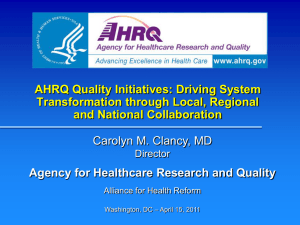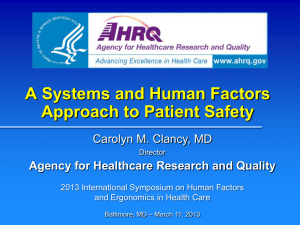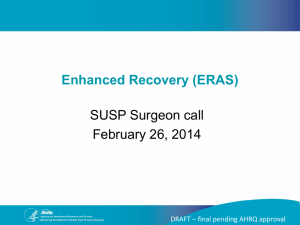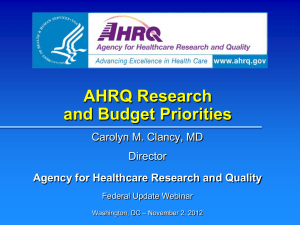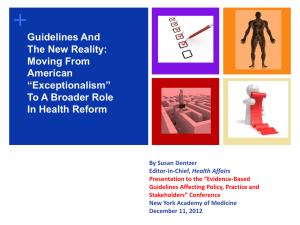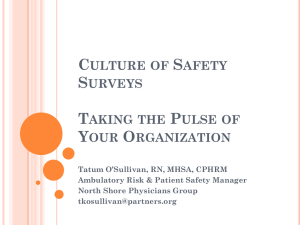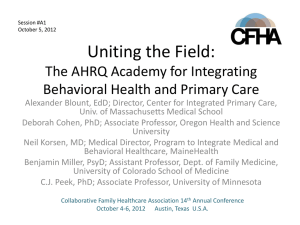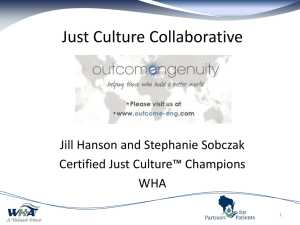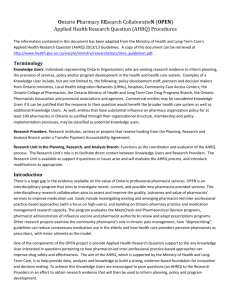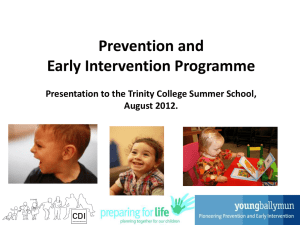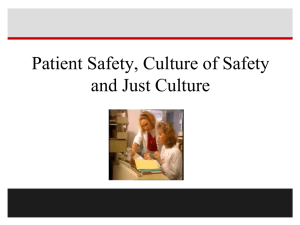Carolyn Clancy - VCU Health Sciences
advertisement
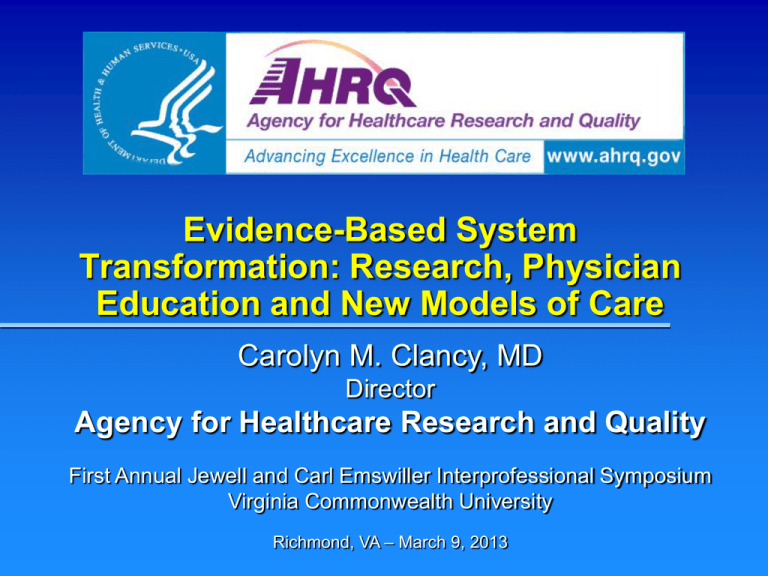
Evidence-Based System Transformation: Research, Physician Education and New Models of Care Carolyn M. Clancy, MD Director Agency for Healthcare Research and Quality First Annual Jewell and Carl Emswiller Interprofessional Symposium Virginia Commonwealth University Richmond, VA – March 9, 2013 What We Think We Know “The truth is that for a large part of medical practice, we don’t know what works. But we pay for it anyway.” H. Gilbert Welch, MD Geisel School of Medicine at Dartmouth Testing What We Think We Know. New York Times - August 19, 2012 Health System Transformation: Current and Future Current Future Variable quality; expensive, wasteful Consistently better quality; lower cost, more efficient Pay for volume Pay for quality Pay for transactions Care-based episodes Quality assessment based on provider and setting (process) Quality assessment based on patient experience (outcomes) And Big Questions Still Need Answers Although health care reform has begun, these questions remain: – How is evidence on safety and – – – – quality improvement integrated into the new environment? How has the nature of evidence changed? How do these changes affect patients, providers, payers? How do we ensure that these changes are beneficial? How are improvements put into practice? CHANGE AHEAD So, Where Does That Leave Us? Making progress, but our destination is in the distance Progress in quality improvement and patient safety is taking place, but at a slow and uneven pace Payment based on quality and safety performance is not a passing fad; role of teamwork is now valued Movement to patientcentered care* also an evolving process *Institute of Medicine proposed 6 aims for the health care system: safe, effective, patient-centered, timely, efficient, and equitable. (Crossing the Quality Chasm, 2001) Evidence-Based System Transformation AHRQ’s New and Ongoing Priorities Why System Transformation is Needed in Quality and Safety Improvement Evidence-Based Interventions Patient-Centered Care in an Era of Transformation Q &A AHRQ Priorities Patient Safety Health IT Patient Safety Ambulatory Patient Safety Safety & Quality Measures, Organizations Patient Safety Grants (incl. simulation) Drug Management, & Patient-Centered Care Survey of Patient Safety Culture Diagnostic Error Research Effective Health Care Program Comparative Effectiveness Reviews Patient-Centered Outcomes Research Clear Findings for Multiple Audiences Medical Expenditure Other Research & Dissemination Activities Panel Surveys Visit-Level Information on Quality & Cost-Effectiveness, e.g., Medical Expenditures Annual Quality & Disparities Reports Prevention & Pharmaceutical Outcomes U.S. Preventive Services Task Force MRSA/HAIs AHRQ’s TOP 3 Focus Areas Patient Safety • Build a “trustworthy” delivery system, minimize the impact of adverse events Quality • Focus on the National Quality Strategy and collaboration (HHS, private sector) “Getting to HOW” • Practical, evidence-based process improvements National Quality Strategy: Three Broad Aims Created Under the Affordable Care Act Better Care Improve the overall quality, by making health care more patient-centered, reliable, accessible and safe Healthy People/ Healthy Communities Improve the health of the U.S. population by supporting proven interventions to address behavioral, social and environmental determinants of health, in addition to delivering higher-quality care Affordable Care Reduce the cost of quality health care for individuals, families, employers and government www.healthcare.gov/center/reports/quality03212011a.html With a Focus on Six Priorities Making care safer by reducing harm caused in the delivery of care Ensuring that each person and family are engaged as partners in their care Promoting effective communication and coordination of care Promoting the most effective prevention and treatment practices for the leading causes of mortality, starting with cardiovascular disease Working with communities to promote wide use of best practices to enable healthy living Making quality care more affordable for individuals, families, employers, and governments by developing and spreading new health care delivery models Partnership for Patients: HHS Public-Private Initiative By end of 2013: 40% decrease in instances of hospital patients acquiring preventable conditions, including: – – – – – – – – – Central line-associated bloodstream infections Catheter-associated urinary tract infections Surgical site infections Ventilator-associated pneumonia Pressure ulcers Adverse drug events Venous thromboembolisms Injuries from falls Injuries from obstetrical adverse events Funded by the Affordable Care Act 20% decrease in preventable readmissions due to complications during a transition from one care setting to another www.healthcare.gov/center/programs/partnership/index.html On The CUSP: Stop BSI Part of HHS Action Plan As part of Action Plan, AHRQ funded $18 million national effort Goal: Reduce CLABSI rates to < 1 per 1,000 central line days across all hospitals in project Partnership with JHU Quality and Safety Group, Health Research and Educational Trust (AHA affiliate), and Michigan Hospital Assn.’s Keystone Center On the CUSP: Stop BSI Project Update To date, 45 state hospital associations and 1 other umbrella group have committed to leading project in their states Groups have recruited more than 1,100 hospitals and 1,800 hospital teams to participate Twenty-three states began project in 2009, 14 states and District of Columbia began during 2010, and 9 States and Puerto Rico began efforts in 2011 CUSP Cuts CLABSIs by 40 Percent in 1,100 Hospital Units Nationwide patient safety project – – Developed at Johns Hopkins, tested in Michigan Implemented in more than 1,100 hospital units Results: – – CLABSIs reduced from 1.903 infections per 1,000 central line days to 1.137 per 1,000 days Savings: more than 500 lives, $34 million in costs New toolkit for implementation AHRQ Patient Safety Project Reduces Bloodstream Infections by 40 Percent. Press Release, September 10, 2012. www.ahrq.gov/news/press/pr2012/pspclabsipr.htm Evidence-Based System Transformation AHRQ’s New and Ongoing Priorities Why System Transformation is Needed in Quality and Safety Improvement Evidence-Based Interventions Patient-Centered Care in an Era of Transformation Q &A 2012 National Healthcare Quality and Disparities Reports: New Features AHRQ’s National Quality and National Disparities Reports: – 2012 will be 10th in series – Addition of more NQS measures reflecting population need – Focus on long-term trends – Focus on new HHS race/ethnicity standards NHQRDRnet – Addition of function to generate customized graphics 2011 National Healthcare Quality and Disparities Reports Overall health care quality in the US is improving slowly Access to health care not improving for most racial and ethnic groups On average, Americans receive appropriate: – Acute care services 80% of the time; – Recommended chronic disease management services 70% of the time; – Preventive care services 60% of the time Quality is Improving Slowly Quality measures that are improving, not changing or worsening, overall and for select populations Across all measures of health care quality tracked in the reports, almost 60% showed improvement However, median rate of change was only 2.5% per year Improvement included all groups defined by age, race, ethnicity, and income AHRQ 2011 National Healthcare Quality and Disparities Reports Quality Measures Most Rapidly Improving or Worsening Quality Improving Quality Worsening Adult surgery patients who received prophylactic antibiotics w/in 1 hr before surgical incision Postoperative pulmonary embolism or DVT per 1,000 surgical hospital discharges, adults 18 or over Adult surgery patients who had prophylactic antibiotics discontinued w/in 24 hours after surgery end time Hospital admissions for shortterm complications of diabetes per 100,000 population Hospital patients with heart attack Maternal deaths per 100,00 live who received percutaneous births coronary intervention w/in 90 minutes of arrival AHRQ 2011 National Healthcare Quality Report Making Care Safer Improvements in safety are lagging – The reports track 26 safety measures related to HAIs and other hospital-related adverse events – Of these measures, 38% showed improvement – By comparison, among 16 hospital quality measures not related to safety, almost all showed improvement over time 2011 AHRQ National Health Care Quality and Disparities Reports Virginia Snapshot: Overall Health Care Quality Measures Measure Performance % of adults age 18 and over who have Better than average had their blood cholesterol checked within the last 5 years Average Adult surgery patients who received prophylactic antibiotics within 1 hour prior to surgical incision Worse than All cancer deaths per 100,000 average population National Healthcare Quality Report, State Snapshots Evidence-Based System Transformation AHRQ’s New and Ongoing Priorities Why System Transformation is Needed in Quality and Safety Improvement Evidence-Based Interventions Patient-Centered Care in an Era of Transformation Q &A Medical Liability and Patient Safety Initiative Part of Affordable Care Act Supports implementation and evaluation of evidence-based patient safety and medical liability projects Seven AHRQ-funded demonstration grants have been awarded to test models that: – – – Reduce preventable harm Inform injured patients promptly and making efforts to provide prompt compensation Promote early disclosures and settlements, through court-directed alternate dispute resolution model Reforming Medical Liability: Seven Pillars Project Launched in 2006 at University of Illinois-Chicago by Dr. Timothy McDonald; focuses on transparency and disclosure to eliminate patient harms and learn from safety events. Seven Pillars components: – Patient safety incident reporting – Investigation – Communication and disclosure – Apology and remediation, including waiver of hospital and professional fees – System process and performance improvement – Data tracking and performance evaluation – Education and training Improving Hospital Safety Culture: TeamSTEPPS TeamSTEPPS® – Evidence-based teamwork system to improve communications and teamwork among health care professionals – Provides higher-quality, safer care by: Increasing team awareness and clarifying team roles and responsibilities Resolving conflicts and improving information sharing Eliminating barriers to quality and safety – Rooted in more than 25 years of research and lessons from application of teamwork principles – Developed by Department of Defense and AHRQ www.teamstepps.ahrq.gov Optimizing TeamSTEPPS for Simulation Training and Rapid Response Systems TeamSTEPPS includes instruction modules applied to simulation-based training rapid response systems Simulation modules integrate critical teamwork, interpersonal, and communication skills into simulation-based training Rapid response modules provide insight into teamwork concepts applied to rapid response protocols http://ahrq.gov/teamsteppstools Evidence-Based System Transformation AHRQ’s New and Ongoing Priorities Why System Transformation is Needed in Quality and Safety Improvement Evidence-Based Interventions Patient-Centered Care in an Era of Transformation Q &A Research that Addresses Patient Outcomes Patient-Centeredness: The final frontier? Patient-centeredness may be the most challenging of all 6 domains of quality, because it is so difficult to define and measure But, it is also likely the most important, because it includes elements of all other domains Implementing EvidenceBased Treatment Decisions Which treatments work, for which patients, and what are the trade-offs? – Patient-centered outcomes research informs decisions by providing evidence and information on effectiveness, benefits and harms How can evidence-based improvements be translated and shared with providers, patients? – Effective Health Care Clinician and Consumer Summaries – Continuing Medical Education – Center for Medicare and Medicaid Innovation; AHRQ Health Care Innovations Exchange AHRQ’s Effective Health Care Program AHRQ’s Effective Health Care Program, created by the Medicare Modernization Act of 2003 Program has published more than 100 products, including summaries for clinicians, consumers and policymakers, with plans for at least 75 more over two-year period Emphasis on synthesis of existing evidence and creation of new evidence EHC Products Developed By the Eisenberg Center www.effectivehealthcare.ahrq.gov Recently Released Translation Products ADHD in Children ANA and RF tests for Musculoskeletal Complaints in Children Chronic Pelvic Pain Mechanical Thrombectomy Pain Management in Hip Fracture Preventing Fractures in Low Bone Density Urinary Incontinence in Women AHRQ’s Guide to Patient and Family Engagement: Environmental Scan AHRQ-funded environmental scan conducted to serve as evidence-based foundation for development of Guide to Patient and Family Engagement. Highlights: – Quality and Safety: Both patients and providers think that the quality of care they receive or give is generally good; they do not share same views on what constitutes quality or safety – Engagement: In theory, patients and providers support patient and family involvement and recognize it can lead to better patient experience and outcomes. Support is more uncertain when patient engagement includes higher level of involvement, i.e. making diagnosis or treatment decisions. AHRQ’s Guide to Patient and Family Engagement: Environmental Scan Highlights – Engagement: Patients more likely to engage when goals relate to obtaining specific information about their care (asking questions about condition), but less likely to engage when faced with behaviors that seem new or confrontational (asking providers to mark surgical sites) – Barriers and facilitators to engagement: Patients and family members: Fear, uncertainty, low health literacy and provider reactions. Facilitators include self-efficacy, information, invitations to engage, and other provider support. Health providers: Professional norms and experiences, fear of litigation, perceived level of effort. Facilitators include leadership, occurrence of sentinel event, business case for quality and safety, patient stories, altruism AHRQ’s Guide to Patient and Family Engagement: Environmental Scan Key Findings to Inform Future Development of Patient and Family Engagement Guide: – Existing approaches to and resources for patient and family engagement lack strong evidence base of efficacy or effectiveness – Gaps in content and topic areas include: Strategies not attuned to patient and family member experience of hospitalization Lack of individual tools to support hospital-level strategies Lack of concrete, actionable support for individual users to engage in behaviors Dearth of materials for nurses on how to better communicate with patients http://www.ahrq.gov/qual/ptfamilyscan / Innovations and Tools To Improve Quality, Reduce Disparities AHRQ Health Care Innovations Exchange – Find evidence-based innovations and quality tools – View new innovations and tools – Learn from experts through events and articles http://Innovations.ahrq.gov Patient Centered Outcomes Research Dissemination Framework Example: New Diabetes CER • Media campaign • Outreach to national orgs (i.e. ADA, AADE, Endocrine Society, AACE) • Outreach to consumers • Integrate clinical message into Diabetes AD package • Promote/discuss in individual practice settings • Create and promote CE modules based on individual findings National awareness of CER and specific findings Publicity Center Deeper awareness of CER and findings at regional, local, or system level Regional Offices Individual clinician education and practicelevel implementation Academic Detailing & Online CE Evaluation • Integrate message into Diabetes package • Promote via regional/State chapters of national orgs, local advocacy orgs, and regional health systems Prioritization and Message Development The Patient-Centered Outcomes Research Trust Fund and AHRQ Provides funding for AHRQ to disseminate research findings of the Institute and other government-funded research, train and build capacity for research www.pcori.org – Up to 20% of Patient-Centered Outcomes Research Trust Fund can be used to support research capacity building and dissemination activities Closing the Quality Gap: Revisiting the State of the Science Series of reports summarizing the evidence on quality improvement strategies for chronic conditions and other priorities: – – – – – Bundled Payment Health Disparities Patient-Centered Medical Home Public Reporting Medication Adherence http://www.ahrq.gov/clinic/tp/gapbundtp.htm Prioritizing Future Research Needs Identifying Research Needs for Improving Health Care * Article describes challenges and lessons learned in developing a systematic approach to identifying and prioritizing future research needs (FRN) Based on the approach initiated by EPCs in 2010 to better define patient-centered research needs from selected systematic reviews Focuses on stakeholder involvement as an essential tenet in the process Cycle and Effect of New Research* New Research Studies Systematic Reviews Future Research Needs Chang S, Carey T. Ann Inter Med. 2012;157:439-445 Uptake and Use of Evidence by Decision Makers A Decent Meal, Or a New Model of Care? The challenge: – Serving millions of people – Delivering a range of services – Keeping costs reasonable – Attaining a consistently high level of quality Can care be mechanized? Should it be? Are there models we can use? Gawande A. Big Med: Restaurant chains have managed to combine quality control, cost control, and innovation. Can health care? New Yorker. August 13, 2012 What Should the New Model Look Like? That remains to be determined, although overall factors to consider include: – Engaging stakeholders at the point when strategic decisions are being made – Making evidence available earlier and during different intervals of a project – Thinking of publication as one step in the continuing process to get results into the hands of those who need it rather than the end of the research cycle – Testing multiple conclusions in the field rather than waiting until there is a ‘right’ answer The Journey from Patient Safety Knowledge to Practice What we know: – It’s a long journey – Holds unexpected surprises – Not just one way to get there – Bottom line: Improving safety requires that we understand how patients and families perceive their care, recognize different degrees of engagement, and be willing to form partnerships to provide safer care Traveling Fast or Traveling to Get Somewhere? If you want to travel fast, you travel alone. If you want to go far, travel with others. African Proverb Thank You AHRQ Mission To improve the quality, safety, efficiency, and effectiveness of health care for all Americans AHRQ Vision As a result of AHRQ's efforts, American health care will provide services of the highest quality, with the best possible outcomes, at the lowest cost www.ahrq.gov

